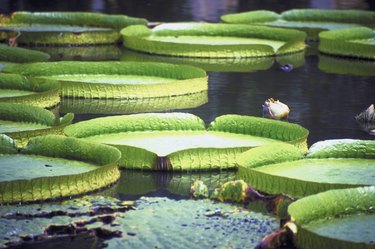
The giant water lily, or Victoria amazonica, is known for its floating, 4- to 6-foot diameter leaves, which are surrounded by a 2- to 4-inch ridge. Native to the Amazon region of South America, the aptly named giant water lily has been found along the banks of the Amazon River and once was grown in England's Kew Gardens during Queen Victoria's reign.
Size and Scope
Video of the Day
Also known as the Amazon water lily, royal water lily or Amazon water-platter, the giant water lily is an aquatic, oval-shaped perennial that catches the eye with its floating leaves. Even more striking is the lily's outer edge, which rises 2 to 4 inches around the perimeter of the leaf. The giant water lily's leaves are yellow-green in color with a copper-colored, prickly underside.
Video of the Day
Blooming Characteristics
The giant water lily's pineapple-scented, night-blooming flowers emerge at dusk and close by noon. The 9- to 12-inch-size flowers bloom for three days, starting with a creamy white shade on day one, a pinkish hue on day two and a purplish-red color on day three. Strongly fragrant and double-sized, the giant water lily's blooms occur annually from July through August.
Hardiness and Cultivation
Considered a high-maintenance specimen, giant water lilies are often grown in containers for specialized water gardens, pools or ponds. Giant water lilies can be cultivated in U.S. Department of Agriculture hardiness zones 10 and 11, as long as water temperatures do not dip to less than 75 degrees Fahrenheit. A tropical-hardy plant, the giant water lily requires plenty of full sun and water depths of 1 to 3 feet. While a giant lily is generally immune to most insect and disease problems, the water environment should be free of any splashing, heavy winds or strong currents, according to the Missouri Botanical Gardens.
Unusual Facts
The petioles and midribs of a giant water lily are sharp enough to prevent coagulation of the blood, which can be dangerous in areas of the Amazon River where piranas swim. The giant leaf is more buoyant than it looks and will even support the weight of a man. The plant's scientific name, Victoria, was added in 1837 as a tribute to Queen Victoria by English botanist John Lindley, who introduced the specimen in the Kew Gardens. In Missouri's Botanical Gardens, some of the giant water lily specimens on site can be traced to the Kew Gardens.